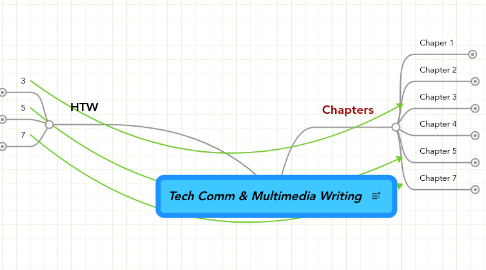
1. Chapters
1.1. Chaper 1
1.1.1. Technical and Professional Communication
1.1.1.1. Communication about complex, highly detailed problems, issues, or subjects in the professional world, which helps audiences visualize and understand information so they can make informed and ethical decisions or take appropriate and safe actions
1.1.2. Writing in the Workplace
1.1.2.1. “Workplace writers” help to negotiate and create the knowledge users need by: --Creating texts that interact with various audiences-- Making complex information understandable to audiences who need it-- Serving as a bridge between groups, both inside and outside their organizations --Reducing internal costs of production, support, and development
1.1.3. Characteristics of Technical and Professional Writing
1.1.3.1. Rhetorical
1.1.3.1.1. Solves problems, affects an audience, and reflects one’s credibility
1.1.3.2. Audience Centered
1.1.3.2.1. Genre, style, level of formality, level of detail, format and length
1.1.3.3. Technology Oriented
1.1.3.3.1. Produces from and produces for a variety of analog and digital technologies
1.1.3.4. Ethical
1.1.3.4.1. Aware of consequences in the real world
1.1.3.5. Research Oriented
1.1.3.5.1. Gathers information from a variety of sources, from libraries and personal communication
1.1.3.6. Professional
1.1.3.6.1. Clear and accessible, using appropriate forms and content
1.1.3.7. Visual
1.1.3.7.1. Pairs visual and written registers for effect
1.1.3.8. Design Centered
1.1.3.8.1. Combines aesthetics and readability
1.1.3.9. Concise
1.1.3.9.1. Efficient in wording
1.1.4. Problem-Solving
1.1.4.1. Plan, Research, Draft, Revise, Distribute
1.2. Chapter 2
1.2.1. http://www.jstor.org/pss/358260
1.2.2. http://spot.pcc.edu/~rjacobs/career/resolving_workplace_problems.htm
1.2.3. http://collegewriting.us/Lists/Readings%20%20Thinking%20Rhetorically/AllItems.aspx
1.2.4. http://www.rpi.edu/dept/llc/webclass/web/project1/group4/
1.3. Chapter 3
1.3.1. Format and design is made easy with word processors but is up to the writer to determine proper spacing and dimensions.
1.3.2. Creating multiple documents in various formats from the same content are single-sourcing programs
1.3.3. It is a good idea to keep points short and precise when communicating with group members
1.4. Chapter 4
1.4.1. http://wps.ablongman.com/long_lannon_techcomm_9/0,7046,138586-,00.html
1.4.2. http://www.writerswrite.com/journal/mar02/delm.htm
1.5. Chapter 5
1.5.1. Transnational- encompasses multi-national, cross-cultural, global, and international audiences and Suggests a sense of movement, particularly the flow of goods and services and the flow of communication and information
1.5.2. localization is defined as “adapting a product and translating a document for a specific local audience”
1.5.3. Internationalization is defined as: “the process of writing, rewriting, designing and redesigning documents so that they can be more easily localized to any transnational audience”
1.6. Chapter 7
1.6.1. Use increasing order of importance when you your audience won’t have a printed copy
1.6.2. Balance abstract ideas and concrete details within the document. Move from general to specific to provide background, scope, and context for the more specific information
1.6.3. Explain relationships between events or reasons that something has happened or will happen Understand that you are reporting plausible, not definitive, causes
2. HTW
2.1. 3
2.1.1. Format refers to both the organization of information in a dorument and the physical arrangement of the information on the page
2.1.2. Format also refers to the general physical appearance of a finished document, whether printed or electronic
2.1.3. In one sense, format refers to the fact that some types of job related writing are characterized by conventions that govern the scope and placement of information
2.2. 5
2.2.1. Considering the needs of your audience is crucial to achieving your purpose.
2.2.2. The first step in analyzing your audience is to determine the readers' needs relative to your purpose and goals.
2.2.3. In the workplace, your readers are usually less familiar with the subject than you are so you must be careful when writing on a topic that is unique to your area of expertise
2.3. 7
2.3.1. Every presentation is given for a purpose, even if it only to share information.
2.3.2. Once you have determined the desired end result of the presentation, analyze your audience so you can tailor your presentation to their needs
2.3.3. Once you have focused the presentation, you need to find the facts and arguments that support your point of view or the action you propose
